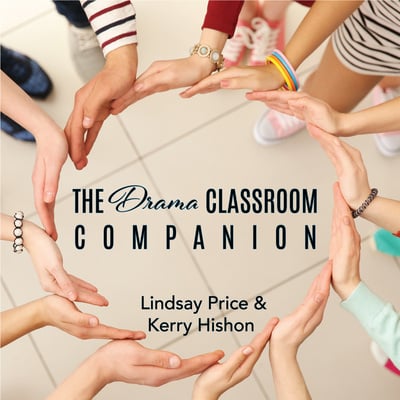Agatha Rex by Lindsay Price is a bold high school take on Antigone - packed with heart, conflict, and a powerhouse ensemble. One girl. One stand. One huge risk. *NEW COMPETITION VERSION AVAILABLE!*
Dealing With Rehearsal Rut
It’s easy to get caught in a rhythm during the rehearsal process. Lines must be memorized, blocking must be learned, it’s the same rhythm over and over again. Before you know it, it’s opening night and you’re asking yourself,
“Where did the time go? What did we do?”
Sometimes you find yourself late in the rehearsal period with students who have lost their passion and energy for the piece. Maybe you’ve lost your passion and energy for the piece. You’ve become stuck in rehearsal rut.
Rut: A habit or pattern that becomes dull but is hard to change.
Shake up your rehearsal to keep students engaged in the process. Break away from the script with some character development. Do an out-of-context line exercise. Have a Q&A session. Have some fun!
These exercises not only break the rhythm, they also show your actors (and you) what they know and what needs work. Provide a focus and a drive as you head toward opening night.
Change Your Warm-Ups
There is something comforting about doing the same warm-ups repeatedly. It provides structure: this is how rehearsals start. Structure can give you a valuable transition from the “outside” world to rehearsal world. But a great way to shake up rehearsals is to change the warm-up. Instead of warming up as actors, have your students warm-up in character.
- Students are spread around the room. Explain that they are now in character and that every choice they make for this warm-up should be in character. Think about how your character acts, reacts, moves and speaks differently than you do.
- Emphasize these differences by directing students to stretch in character. Reach up as your character, think about how old you are, how far you can stretch your arms. Reach out to the side, always staying in character. Do the ragdoll (reach up and then flop forward from the waist) and roll up vertebrae by vertebrae, continually coaching students to stay in character.
- Direct students to move about the room in character. Think about your character’s pace and speed. Do they walk always in a straight line? Do they wobble? Do they make a lot of sudden changes in direction? Stay focused, stay in character. If you make eye contact with anyone, you can say hello – in character. If your character doesn’t like another character, make it clear.
- Have students come to a halt. Coach them to stand so that they are not making eye contact with anyone else. Make sure everyone stands as their character would. How does your character stand? Remember, you are different than your character. Make your stance different. Where do you hold your hands? Where are your shoulders? Make this pose the most defined and expressive stance for your character.
- Direct students to think about the problems their characters face in the play. What are your problems? Think about the issues that make you really tense. Where do you (the characters, not the actors) hold tension? Is it in the shoulders? Do you get stomachaches? Headaches? Exaggerate the tension you feel right now. Hold on to the area where you feel that tension.
- Direct students to walk around the room, maintaining the tension in their bodies. Think about the tension you feel right now. Think about what problems you have to face. Make that tension so intense you can barely walk. It’s so bad you have to come up with a way to get rid of it. How do you get rid of that tension? What do you do to get that tension out? Do you sing? Jump up and down? Run around the room? Do you scream? Come up with an action and a sound that you, the character, does to get rid of tension. Make it big and make it loud – that’s the only way to get rid of the tension.
- Direct students that on the count of three everyone is going to do their sound and their action at the same time. Coach them to release that tension. Reiterate that they should make it big and loud. One, two, three go!
- Direct students now to move about the space tension-free, in character. You’ve got rid of the tension and you’re feeling good about yourself. How do you walk? How do your shoulders move? Do you bounce? Are you grounded?
- Once the students are moving with purpose about the space, tell them they are going to start greeting the other characters in the play. Pretend you’re walking down the street. When I say, “Go,” greet the first person you come in eye contact with, in character. Make sure you’re reacting to them based on your relationship in the play. Are you close? Friends? Enemies? Maybe you don’t know them, that’s ok. Talk to this person. Tell them where you’re going and why you’re walking down the street. Go!
- Coach students to leave that first person and find another person to greet.
- Once they’ve completed three sets of greetings, coach students to come to a neutral standing position and shake the character out of them. Coach them to exaggerate the shake.
Out of Context Line Exercises
Learning lines comes easy to some, and not so easy to others. A common problem student actors have is they learn their lines solely within the context of the play – they associate each line with a specific piece of blocking. They get into a specific rhythm with the line because they’ve learnt it by rote. They get into a line rut.
But what if another actor blanks? Or changes the blocking? Or says the wrong line from three pages ahead? Dependence on a certain rhythm or with everything going perfectly is a recipe for disaster.
Use these exercises to get actors out of their line ruts.
1. Speed Round: Students spread out around the space. Ask them to close their eyes and think about their lines. On the count of three, have everyone start at the top of the play and say their lines, all at the same time. Coach them to keep their eyes closed, so no one can see them and they can’t see anyone. Coach them to say their lines as fast as they can without stopping. They don’t have to act the lines, just say them. After a couple of minutes, call out stop. Question the actors about the exercise:
-
- Did anyone have trouble saying the lines without acting? Ask them to reflect on why that happened. What are they relying on to help them with their lines?
- Did anyone get stuck? Where did they get stuck? Have those actors pull out their scripts and circle the lines – this is where they need to do some homework.
2. Shout Out Game: Go through the script and pull out ten individual lines. Take them from the middle of monologues, from the beginning of the play, from the end. Create a list of these ten lines. Make sure the list is not in chronological order. Gather the cast and call out each line one at a time. Who knows where the line comes from? Who says it? What’s the next line? What’s the previous line? Coach your students to shout out the answers! This will give you a clear indication of who really knows the play.
3. The Situation: Go through each scene in the play and ask your students to write a one sentence description of what happens. It doesn’t matter if they’re in the scene or not – what happens in scene 2? Then have everyone write a one sentence on why each scene is important. What’s going on? Why is it important? Everyone on stage should know what’s supposed to happen and why. That way they can help each other when things go wrong.
4. All dried up: Students need to learn what to do when a scene goes off the rails. More often than not, if a line is missed, or someone speaks out of place, students will look around for someone else to solve the problem. Run through a scene with your actors. Tell them that at some point, one person in the scene has been given the directive to “dry up.” They’re going to forget a line on purpose. (You can do this by handing out slips of paper to the actors and if they get a slip of paper with an X on it, they’re the one who dries.) When that happens everyone else must carry on. They have move the scene forward, in the correct direction, in character. No one can call out “line,” no one can break character, and the person who has “dried up” is not allowed to help.
5. What line defines you? This exercise allows the actors to think about the lines outside the world of the play. Each actor should know his or her lines well enough that they can choose the one line which defines their character. They should know their character well enough to be able to experiment and explore their lines outside their context. NOTE: Make sure actors don’t choose a full monologue or a long chunk of dialogue. It should be one or two sentences. Ask your students the following:
- What is the most important line for your character in the play?
- Why does that line define you?
If you have actors without lines or they don’t have any character-driven lines, ask them to pick the moment in the play rather than a line. Have these students write out this moment in one sentence. That will be their “line” for the purposes of this exercise.
Ask students to say the line out loud. All at the same time. Ask them to say the line with different styles and emotions: Say it slow. Say it fast. Yell it. Whisper it. Laugh it. Be angry with the line. Be depressed with it.
Ask the actors to walk around the room. When they make eye contact with someone, they will say their line to each other. Coach students to say the line in a specific way – it could be in the style or emotion they use in the play, but it doesn’t have to be. Have students repeat this with three other people.
Ask students to pause and get in their own space. Direct them to say the line aloud again. Students are now going to come up with a physical action for their line. If you couldn’t speak, what physical action would define this line? Be creative – do you roll into a ball? Do you skip? Do you flail? Do you reach up to the sky? Do yoga? Kick? Remind students this is not just some random action, this is an action that represents this line which defines their character. Is the emotion of your line coming out in the action?
Direct students to do their action with their line. Everyone does this at the same time. Have them repeat this three times. Then, have students complete the action without the line. Just the action, no sound. Repeat the action three times.
Now, instead of saying the line, instead of saying words, come up with a sound. Again, choose a sound that represents the line which defines the character. Is it a yell? A note? A hum? A grunt? A groan? Coach students not to use any words with this sound. It is a noise. Ask students: What’s the emotional quality of the line? What sound matches that emotional quality? Say the line again. Now do just the sound. No action. Do it again.
Direct students to do the sound and action together. Coach students: Put your heart into it. Commit to it. This is the line or the moment that defines you. Bring that line to life through this sound and action.
Ask for a couple of volunteers to present their sound and action to the group. See if the rest of the group can figure out what line is represented with the sound and action.
Finally, ask students to reflect on the connection between the line, the sound and the action. Why did they choose that specific sound or action? If you’re doing this play as a class project have students write it down in their journals. If it’s a production, have students write this reflection in their script. This way, they can refer to it later. And ask them to do just that – Think about that sound and that action that defines you. How can you incorporate that into a moment on stage?
Character Profiles
The more an actor knows about their character, the more depth they can play. It’s important for actors to think about their characters outside of the confines of the story. It’s so easy to get caught up in lines and blocking that character development goes by the wayside. This exercise is a great way to get out of a rut and to bring character development to the forefront.
A Character Profile is made up of any number of details. Characters come to life in the details. This exercise will also help your actors with small roles flesh out their characters.
You’ll find a short Character Profile at the end of this guide. Give the actors a maximum of 15 minutes to answer these questions – make it an instinct exercise. Use it to shake up your rehearsal, but don’t let it be a time suck.
Here are some guidelines:
Full Name: If the character’s full name isn’t given (or if they have no name at all) the actor should come up with it. What’s their middle name?
Family: What is the character’s family situation? Does the character come from a large or small family? Does the character live with both parents? Is the family situation happy? Tense?
What makes you laugh / angry: Pretty self-explanatory. Once actors define this, identify parts in the script that trigger these emotions. When does the character laugh in the play? When does the character express anger?
Favourite / Least Favourite Food: Everyone has likes and dislikes. So should your character.
Childhood memory: Many people are defined by childhood events. What does your character remember from childhood?
Describe Your Bedroom: Is it neat? Messy? Designed? Plain? Does your character hide secrets in their room? What does the room say about the character?
Character Questions
In addition to the Character Profile , provide a character-specific question for your actors. Each character gets their own question, which only they can answer. It takes some effort on your part, but it’s a worthwhile exercise. First, it’s something specific for every actor and that makes them feel important. Second, the right question can allow actors to think about their characters in a way they might not have previously.
For example, here are a number of questions I came up for the actors rehearsing my play The Bright Blue Mailbox Suicide Note.
- JAKE : Why has your friendship with Ken lasted? How long have you and Karen been dating?
- KAREN : You say, “I believe in marriage.” Do you believe you have a future with Jake? Is this a secret, or something you’ve talked about with Jake?
- JOAN : You don’t treat Ken ‘funny’ after his revelation. Why? What is your relationship with Ken?
- BEE BEE : Why is it so important to you to present the persona of “flaky Beebee” to your friends? Does it bother you that Karen, Lisa and Joan don’t know where you work? Why? How long have you known them?
- DENNIS : You talk about what your dad is like. What is your mom like? Describe your relationship with her.
As you can see, the questions are VERY specific! Small, specific work like this takes characters (and your rehearsals) to the next level.
What can students do with these questions? In my Bright Blue example, the actress playing Karen was really excited by her question. She decided that Karen was definitely the type of character who thought about being married. She went so far as to say that Karen was one of those girls who had planned their wedding from the time she was a little girl. In the play, Karen finds her boyfriend pushing her away. The actress came up with a moment where she held her hands as if holding flowers in the traditional wedding pose. As Jake turns away from her, she dropped her hands, as if dropping the flowers.
You can present these questions as part of the Character Profile or present them as part of an Interview Hot Seat Exercise.
Interview Hot Seat: Each actor sits in front of the group and answers questions in character. It could be the questions you’ve come up with, or you can ask everyone in the cast to write down a question for the character. This is a great opportunity for you to see what your characters think about the other characters in the show.
Scene Study
Shake up your rehearsal rut by going through one scene in detail. Invite everyone who’s not in the scene to participate in this scene study. There’s a lot you can learn by watching specific scene work.
Line by Line
Start by running through the scene normally once.
Then go through the scene line by line. Ask actors questions about the content of the scene. Ask about why their character makes any decisions or why they say a certain line. Ask them about background information that comes up in the scene. Are they clear about the relationships in the scene? Answering “I don’t know” is a red flag.
Play Time
After the line reading, go through the scene again and play with it. Give students alternative blocking. Place the scene in a different location entirely. If the scene is a drama, run it as a comedy or viceversa. You’re trying to break your cast out of a rut, so change things up.
For example, when I had the students rehearsing Bright Blue do this scene study I chose a scene where all the characters read a suicide note for the first time. In the play, the characters aren’t sure if the note is real or fake. I had them do the scene and play “keep away” with the note. This brought an energy and a game atmosphere to the scene that wasn’t there before.
Why’d you move?
Next, run through the scene but stop every time someone moves. Ask that actor “Why’d you move?” There should be a character-driven reason for every move. “Because you told me to” is not an acceptable answer. Push your students to come up with a reason why their character decided to sit or stand or move across the room. What is their subtext? Are they uncomfortable and want to get away from someone? Are they interested and want to get close to someone?
You can get rid of Rehearsal Rut!
Sometimes there isn’t enough time to get your production to its best possible performance level. But there should always be time to incorporate even one of these exercises into your rehearsals. Your students will be more aware of their characters, more confident with their lines, and they’ll maintain that vital connection to their passion. We can’t ask for anything more for our students, can we?
Character Profile
Actor:
Character Name:
Family:
What makes you laugh?
What makes you angry?
Favourite / Least Favourite Food?
Describe a childhood memory.
Describe Your Bedroom.
Related Articles
The Drama Classroom Companion
by Lindsay Price & Kerry Hishon
The Drama Classroom Companion is filled with articles and exercises to build the skills needed for theatrical performance as well as real world skills like creative thinking, critical thinking, collaboration, and communication.
The Rehearsal Companion
by Kerry Hishon
You’ve chosen the play, paid the royalties, done the script analysis, held your auditions, and cast the show. Tomorrow is the first rehearsal. Are you ready? Really ready? The Rehearsal Companion can help!





